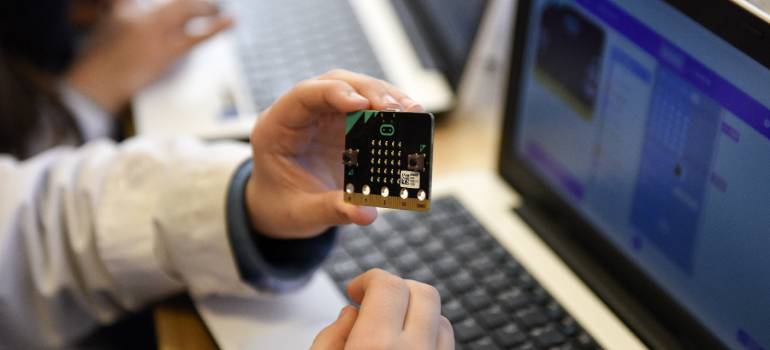- Home
- About us
- News
- Events
- EXPORT Export
-
BUY
Buy
Buy
- INVEST Invest
- COUNTRY BRAND Country Brand
-
INFORMATION CENTER
Information center
InformationCenterInformationCenterReports Country reports Department reports Foreign trade reports Product-Destination worksheet Sectors reports Work documentsStatistical information Classification Uruguay XXI Exports Imports Innovative National Effort Macroeconomic Monitor Tools Buyers Exporters Investors
- Contact
-
Languages
Digital culture: Uruguay's advantages in times of COVID-19
Digitization, access to devices and connectivity allow many sectors of activity to carry out their tasks remotely.
Share:

Through a series of public policies that find their banner in the Ceibal Plan, a program that through technology revolutionized its educational system, Uruguay created a digital culture that, without knowing it, would leave it better positioned in the face of the COVID-19 outbreak.
In Uruguay, the effort towards greater digitalisation has already been underway for years. That is why, in the current situation where students cannot attend classes at education centres, the fact that courses can have a certain continuity is not unusual.
Therefore, as highlighted in a dialogue with EFE by Isabella Antonaccio, a specialist in Information and Communication Technologies (ICT) from the investment, export and image promotion agency Uruguay XXI, the arrival of the COVID-19 pandemic finds the country quite prepared.
Digitization in times of social distance
While the expert clarified that preparation was not geared to circumstances such as this, she acknowledged that many of the country's technology policies come "like a fingertip" at a time when communication and distance work are the best option.
"There is a high level of digitalization, from access to devices and computers by students and teachers to connectivity in homes and businesses. This means that there are many sectors of activity that can continue to develop their tasks," Antonaccio said.
The key piece is the investment the country made in connectivity, with a spending of US$ 600 million in fiber optics. This allowed the Internet to reach 80% of homes with good speed and at an accessible price.
The ICT specialist also pointed out that Uruguay - which is part of the D9, a group that brings together the world's leading countries in digital government - placed emphasis on reducing the digital gap in its population.
One of the undisputed protagonists of this process is the Ceibal Plan, an initiative created in 2007 to support the country's educational plans with technology.
Due to its innovative nature, this plan is today a flagship program that shows the world the cutting-edge initiatives for which Uruguay stands out.
In the shadow of the ceibo tree
With the Ceibal Plan, Uruguay was the first country to implement the One Laptop Per Child program devised by technology expert and founder of the Media Lab at the Massachusetts Institute of Technology (MIT), Nicholas Negroponte, along with other members of MIT.
This plan, for which two million laptops and tablets were given to children and adolescents between 2007 and 2018, has an interesting history of experiences to be put into play in the pandemic, according to the Education Manager of Plan Ceibal, Irene González.
"We are starting from a favorable situation, especially considering what may be happening in other countries of the region when it comes to the deployment of initial infrastructure and universal access to the devices," Gonzalez said.
She added that, both with the Ceibal Plan - named after the ceibo tree, Uruguay's national flower - and the Ibirapitá Plan, which provides tablets to low-income elderly people in the country, there is an accumulated working capital in education technologies that is advantageous in these circumstances.
Specifically, González pointed out that when the suspension of classes was decreed by the authorities on March 14 and then extended indefinitely, Plan Ceibal already had several virtual learning platforms.
The main one, chosen to concentrate the meetings between students and teachers before COVID-19, is the "Crea" platform, where materials from various subjects can be found. According to the manager, since the pandemic a record number of users of about 270,000 per day has been registered.
In addition, Plan Ceibal has two virtual platforms for studying mathematics, both through exercises and games, a library with more than 7,000 contents and a pilot online video-conference tool that is being used by some 200 teachers and is expected to be implemented in the future.
In this sense, González said that one of the key tasks of the plan in the current context is to be aware of the doubts and questions that teachers may have.
"We are working very hard on webinars and virtual workshops because the demand has increased and we believe that at this time it is very important that teachers feel supported by us, that we are close to them to answer their questions," she said.
On the other hand, Gonzalez said that a great challenge for the pandemic plan is to address the inequalities that such situation generates, in order to reach those households that do not have sufficient resources.
"There is a very important challenge in how to reach those students and in how to look for other strategies. We know that schools are working hard and putting the resources in place to reach these children," she concluded.
